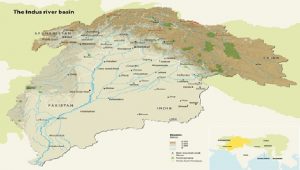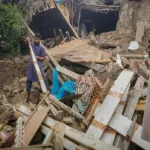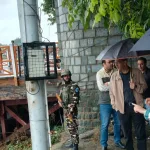The Pahalgam attack has brought the Indus River Treaty back into focus. After the attack the Indian government suspended its participation in the bilateral treaty originally signed in 1960 between Jawaharlal Nehru and Field Marshal Ayub Khan.
The treaty has often come into limelight earlier during crises between New Delhi and Islamabad and has triggered loud discussions on water wars in the sub-continent. However very little thought has been devoted to if the treaty has been effective during all these decades! Hasn’t it become redundant because everything ranging from the demographics of the Indus basin to the flow of the rivers constituting it and the glaciers feeding them have changed.
The redundant treaty has contributed to lack of a clear narrative on the Indus river basin which extends from north eastern Afghanistan to Tibet! The treaty which is about a massive basin drained by Indus and its many glacier fed tributaries has become redundant–it was designed for a different South Asia when Pakistan was 45.9 million people and India was 445.9 million. Today it’s 240 million for Pakistan and 1.45 billion for India with over 300 million people across four countries relying on its water, according to the International Water Management Institute.

A graphic of the Indus river basin spanning across eastern Afghanistan, Pakistan, Northern India and Tibet. (Riccardo Pravettoni)
When signed there were hardly any hydroelectric projects on both sides and the treaty didn’t consider that possibility for the future. Largely glacier fed, today the Indus and its tributaries face a precarious situation across its basin–Himalayan glaciers feeding 60-70 percent of its flow are rapidly reducing–losing 8 billion tons of ice annually.
Eventually it’ll be difficult for Pakistan to hold India responsible for every wrong doing since the Karakoram sub-basin glaciers in Hunza, Shigar and Shyok are under its control. These large glaciers contribute to 52.63 percent flow of the Indus Upper Basin–a major source for the entire river system, according to a paper titled “Large glaciers sustaining the Upper Indus Basin glacier runoff in the future” written by Muhammad Mannan Afzal, Xiaolei Wang and Yi Luo and published in the Journal of Hydrogeology.
On May 7, 2022, Pakistan’s then climate change Minister, Sherry Rehman posted on X social media, the video of a bridge collapse in Hassanabad on Karakoram Highway due to GLOF (glacier lake outburst flood) from the melting Shisper glacier. “Pakistan’s vulnerability is high due to high temperatures,” she wrote.
That’s the truth indeed, the Hindu Kush-Karakoram glaciers melted faster between 2010-19 than the previous decade, reporting a mass loss increase by 65 percent, according to a study by the International Center for Integrated Mountain Development.
All these hydrogeological statistics can’t completely encompass the complexity of the situation and the challenges faced by the Indus River Basin including multiple social, economic and anthropological factors across both the sides of the boundary.
Since being signed, India and Pakistan have fought many wars and faced multiple border tensions with each other. Above all the conflict and war, there have also been many natural disasters. The entire Indus basin has faced many floods, GLOFs and earthquakes but never once have India and Pakistan thought if the treaty needs to be discussed, updated or elevated. Maybe the latter as an exercise needs trust and working relations which India and Pakistan have always lacked and terrorism is certainly a contributing factor to it.
Whether the Pahalgam tragedy of April 22 or multiple other such acts of terrorism inside Kashmir, it’s a fact that terrorism is the biggest contributing factor behind distrust and enmity between India and Pakistan. India has devoted a substantial part of its economy to maintaining its sovereignty over Kashmir.
Compared to all those ruling over the Indus basin geography, ranging from Afghanistan, to Pakistan to Jammu and Kashmir to Tibet–India’s policies and aspirations have been led by democratic principles. Why would India not take pride in Kashmir being its integral part!
India has spent millions of dollars on building bunkers for people all along the border for protection from cross-border shelling in both Jammu and Kashmir. I have witnessed them from the RS Pura stretch in Jammu to the Nowshera border in Rajouri. Federal funds provide three lakhs for individual bunkers for families living on isolated lands and ten lakhs for community neighborhood bunkers.
Why would India spend hundreds of crores to build these bunkers if there was no cross border firing! Meanwhile I have witnessed flooding in these bunkers due to the high ground water table. The problem is when the Indus Water treaty was signed it didn’t consider the ground water resources of the basin.
Unlike rivers, the underground water resources can’t be easily classified by a boundary. Thus there’s no accountability on how these resources are exploited on each side and how it’s impacting the basin’s fragile hydrogeology. Again proving that the treaty isn’t that economy serving as it is portrayed to be.
Indus Basin’s Narcotics Network
Narcotics along the border isn’t a recent phenomenon–the substance smuggling is from colonial times–though lesser in scale and operations then. Even since independence it has dramatically changed both in the type of substances smuggled and the modus operandi. It changed further dramatically after India erected the border fence in early 2000.
The drug peddlers have long worked as “on ground operators” for terrorists and courts of India’s National Investigation Agency (NIA) are replete with cases of cross-border narco-terrorism that operates like a massive operation across the region that the Indus River Treaty encompasses. So when narcoterrorism, terrorism and a conflicted border resides in the Indus basin–why would India not raise fingers at Pakistan when an incident like the Pahalgam terrorist attack takes place and why would it not talk about the Indus River Treaty.
However India shouldn’t stop at just suspending its participation in the treaty. It should work to build a new national policy perspective–and this time it shouldn’t be just on the river and its tributaries’ basin, it should be about the entire transnational river basin, its hydrology, hydrological cycles, economy, society, geopolitics and everything else that makes it significant within the story of India’s rise as a global leader.
Leaders are futuristic! Irrespective of the current India-Pakistan crisis, India should start to think and act like leaders and it should begin by creating a national vision for the Indus River Basin. People killed in Pahalgam were from all over India, a vision like this could be a fitting tribute to them. It could be futuristic vision for sustainable peace.
(The Author is a MOFA 2025 Taiwan Fellow with over two decades of journalistic experience including in Jammu and Kashmir)








